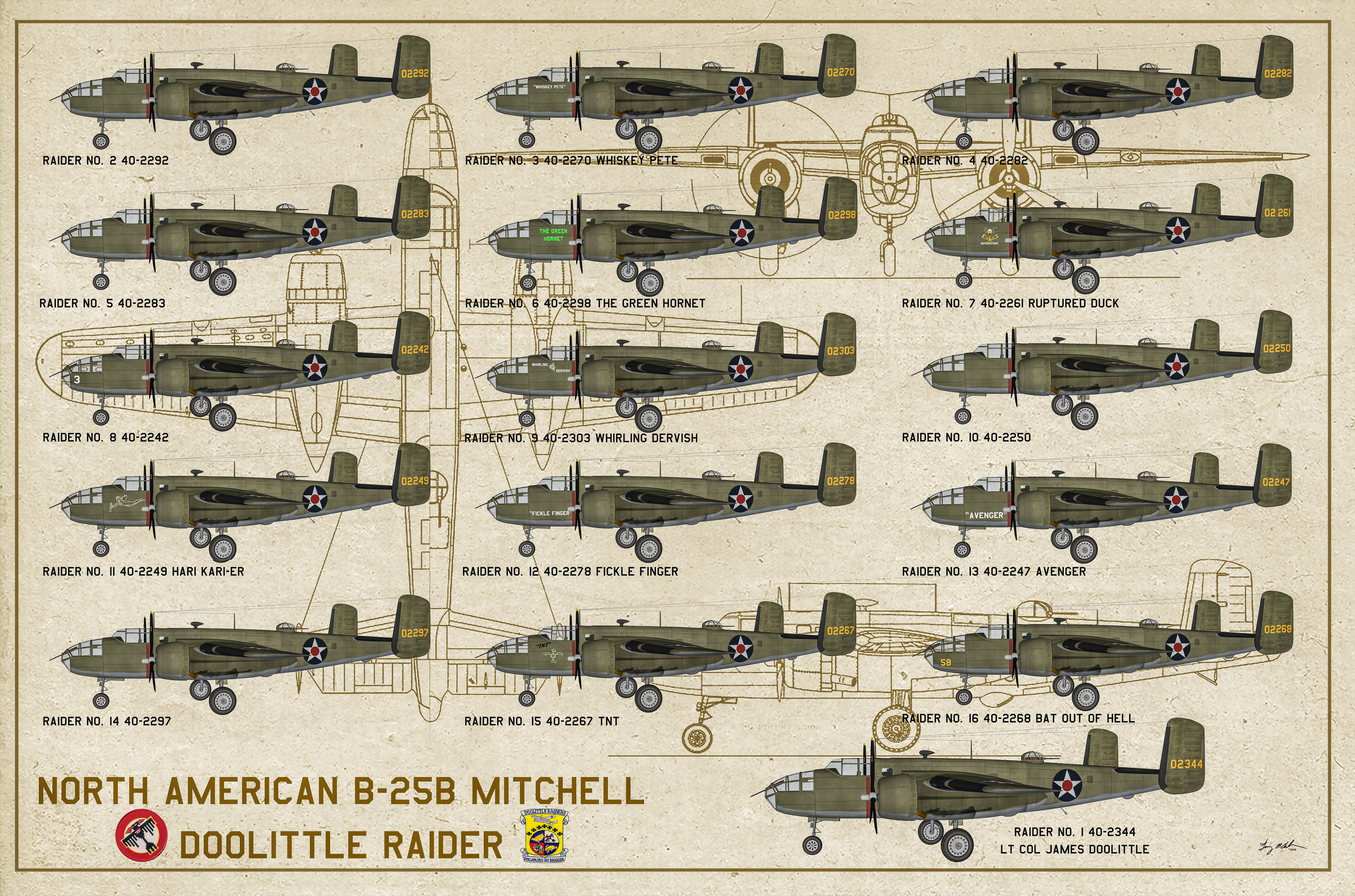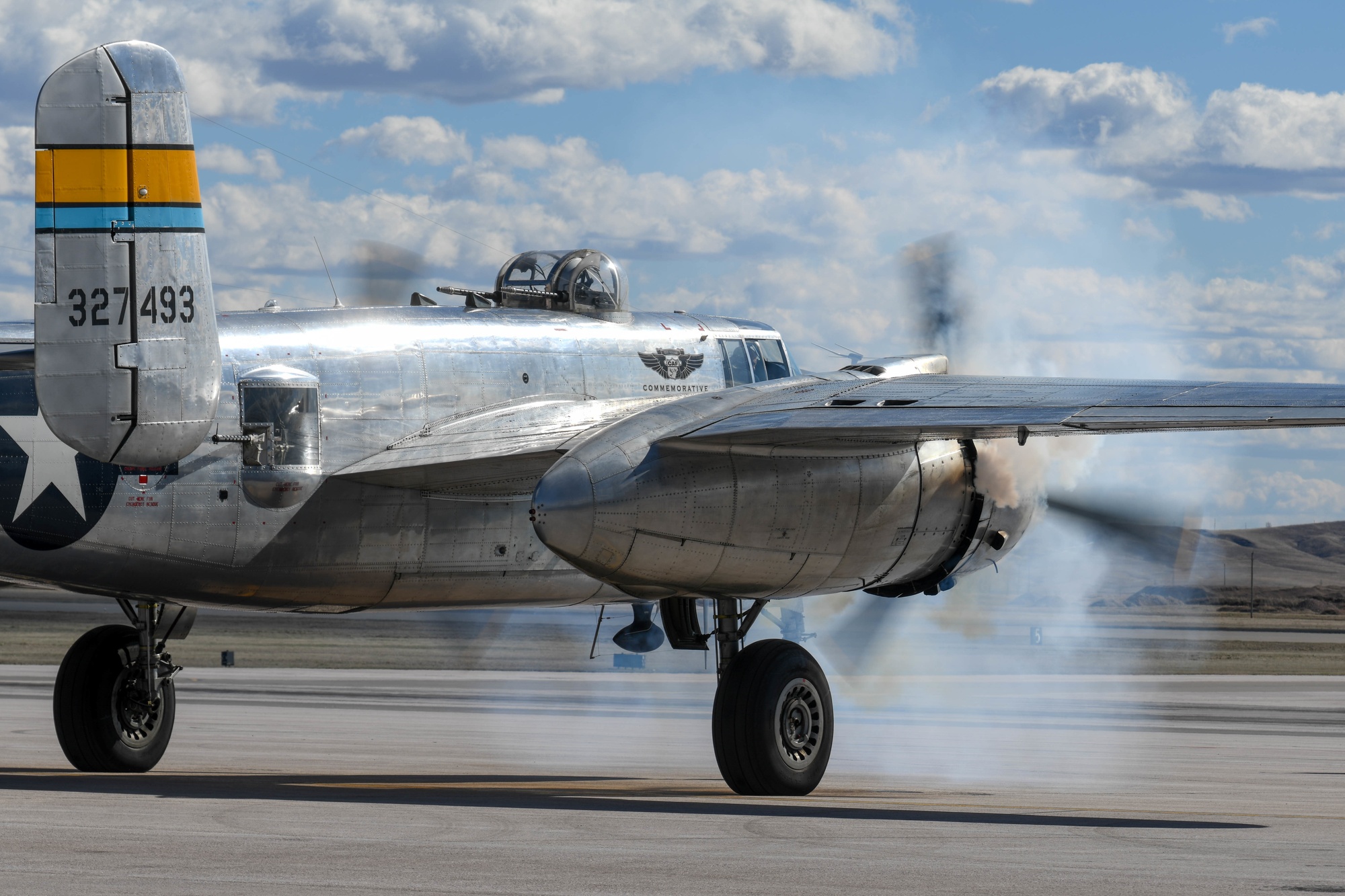B-25 Doolittle Raiders - "Tokyo Raid" redirects here. For the subsequent air raid, sometimes called the Great Tokyo Air Raid, see Bombing of Tokyo (March 10, 1945).
The Doolittle Raid, also known as the Tokyo Raid, was an April 18, 1942, United States air raid on the Japanese capital of Tokyo and other locations on the island of Honshu during World War II. It was the first American air raid to hit the Japanese archipelago. Although the raid caused relatively little damage, it demonstrated the vulnerability of the Japanese mainland to American air attacks. It was the primary retaliation for the attack on Pearl Harbor on December 7, 1941, and provided a significant boost to American morale. The attack was planned, led, and named after Lt. Col. James Doolittle (later Lt. Gerald, US Army Air Force and US Air Force Reserve).
B-25 Doolittle Raiders

The final plan called for 16 B-25B Mitchell medium bombers, each with a crew of five, to be launched from the USS Hornet in the Pacific near Japan. There was no escort for the fighters. After bombing military and industrial facilities, the crews were to continue west to land in China.
North American B25 Mitchell, 40 2249, Hari Kari Er, Doolittle Raid, 1942, 1:72, Corgi Aa35313
On the ground, about 50 people were killed and 400 injured in the raid. Although damage to Japanese military and industrial facilities was minimal, the raid had a major psychological impact. In the US, it raised spirits. In Japan, this created fear and doubts about the military leaders' ability to destroy the home islands, but the bombing and raids on civilians strengthened the Japanese will to retaliate - it was used for propaganda purposes.
The attack also advanced Admiral Isoroku Yamamoto's plans to attack Midway Island in the central Pacific, an attack that resulted in the decisive defeat of the Imperial Japanese Navy (IJN) by the US Navy at the Battle of Midway. The effects of Doolittle's raid were most felt in China: in response to the raid, the Japanese launched the Zhejiang-Jiangxi Campaign, which killed 250,000 civilians and 70,000 soldiers.
Of the 16 USAAF crews involved, 14 five-man crews returned to the US or elsewhere to US forces - one crewman was killed.
Eight US airmen were captured by Japanese forces in eastern China, three of whom were later executed. All but one B-25 was destroyed in accidents, 16 aircraft landed in Vladivostok, Soviet Union.
B 25 Mitchell Bombers To Highlight Events Commemorating 75th Anniversary Of The Doolittle Tokyo Raid
Since the Soviet Union was not officially at war with Japan, international law required the crew to be interned during the war, and their B-25 was confiscated. But within a year, the team was allowed to secretly leave the Soviet Union under the guise of defecting, returning to the United States or elsewhere to US units via Allied-occupied Iran and North Africa.
President Franklin D. Roosevelt spoke to the Joint Chiefs of Staff at a White House meeting on December 21, 1941 and said that Japan should be bombed as soon as possible to boost public morale after Pearl Harbor.
Doolittle noted in his autobiography that the purpose of the raid was to boost American morale and make the Japanese question their leadership: “An attack on the Japanese homeland would confuse the minds of the Japanese and cast doubt on their credibility. leaders... Americans desperately needed a morale boost.

Crew #1 in front of B-25#40-2344, aboard the Hornet, April 18, 1942. Left to right: (front row) Lt. Col. Jimmy Doolittle, pilot; Lt. Richard E. Cole, co-pilot; (back row) Lt. Hry A. Potter, navigator; Sgt. Fred A. Braemer, bombardier; Sgt. Paul J. Leonard, Flight Engineer/Gunner.
North American B 25b Mitchell Doolittle Raiders By Dlm8hn On Deviantart
The concept of the attack came from Navy Captain Francis S. Lowe, Assistant Chief of Staff for Anti-Submarine Warfare. He informed Admiral Ernest J. King on 10 January 1942 that he believed bisexual Army bombers could be launched from an aircraft carrier after observing the outline of a runway painted with several runway outlines at Norfolk Chambers Naval Station. airfoil for landing.
Doolittle, a well-known military test pilot, civilian aviator and aeronautical engineer before the war, was assigned to Army Air Force Headquarters to plan the raid. The aircraft to be used would require a range of 2,400 nautical miles (4,400 km) with a 2,000 lb (910 kg) bomb load, so Doolittle chose the B-25B Mitchell for the mission. The Mitchell had a range of about 1,300 miles, so it had to be modified to carry about twice the normal fuel reserves of bombers. Doolittle also considered the Martin B-26 Marauder, the Douglas B-18 Bolo, and the Douglas B-23 Dragon.
However, the B-26's flight characteristics were questionable from the carrier deck, and the B-23's wingspan was about 50 percent greater than that of the B-25, which reduced the number of aircraft carried aboard the carrier and posed a threat to the ship's superstructure. The B-18 was one of the last two types Doolittle considered, and he rejected it for the same reason.
Doolittle's first report on the plan suggested shortening the flight by 600 nautical miles (1,100 km), based on turning the B-25 around as Ld-Lease so the bombers could land at Vladivostok.
American Doolittle Raid Against Japan Changed The Tide Of Wwii
In April 1941, negotiations with the Soviet Union for permission to land failed because Japan had signed a neutrality pact.
China's Chiang Kai-shek agreed to landing sites in China despite concerns about Japanese repression. Five possible airfields were selected. These locations would serve as refueling stops to allow the teams to fly to Chungking.
Bombers attacking dangerous targets often relied on fighter escort to repel them from enemy fighters, but fighter escort was not possible.

When planning indicated that the B-25 was the aircraft that best met all mission requirements, the two were loaded onto the aircraft carrier USS Hornet at Norfolk, Virginia and departed without incident on February 3, 1942.
Richard Cole, The Last Of The Wwii Doolittle Raiders, Dies At 103
The raid was immediately approved and the 17th Bombardmt Group (Medium) was selected to supply the teams from which the volunteers would be selected. The 17th BG was the first group to receive the B-25, equipping all four squadrons with bombers by September 1941. The 17th Group was not only the Army Air Corps' first medium bomb group, but also in early 1942. were the most experienced B-25 crews. After the United States entered the war, his first assignment was with the US Eighth Air Force.
The 17th BG, which had been flying anti-submarine patrols out of Pdleton, Oregon, was immediately transferred overseas to Columbia Army Air Force Base in western Columbia, South Carolina, to fly similar patrols off the US East Coast, but to actually prepare for the mission. against Japan. The group officially moved to Columbia on February 9, 1942, where combat crews were offered the opportunity to volunteer for an "extremely dangerous" but unspecified mission. On 19 February, the group was detached from Eighth Air Force and officially assigned to III Bomber Command.
The group's 24 B-25B Mitchell bombers were diverted to Mid-Continent Airlines' modification center in Minneapolis, Minnesota. The maintenance hangar at Wold-Chamberlain Field, backed by two major airline executives, became the first modification center to begin operations. The 710th Military Police Battalion from nearby Fort Snelling provided tight security around this hangar. Modifications to the B-25B aircraft include:
A crew of 24 was selected and the modified bombers were picked up in Minneapolis and flown to Eglin Field in Florida beginning March 1, 1942. There, the crews simulated three weeks of carrier deck climbs, low and night flying, low-altitude bombing and water navigation, mostly outside Eglin Support Area No. 1, a more isolated location. U.S. Navy flight instructor Lt. Hry L. Miller of nearby Psakola Naval Air Station supervised their flight training and escorted the crews until takeoff. For his efforts, Miller is being recognized as an honorary member of the Raider group.
Doolittle Raid: B 25b “mitchell” Bombers
In his after-action report, Doolittle reported that the crews had achieved "safe operating" levels, despite several days of flying being impossible due to rain and fog. On March 10, a plane crashed on landing
And a third was aborted due to a nose wheel that could not be repaired in time.
On March 25, 1942, the remaining 22 B-25s flew from Eglin, California to McClellan Field. They arrived at Sacramento Air Depot two days later for inspection and final modifications. A total of 16 B-25s were sent to NAS Alameda, California on 31 March. The mission unit consisted of five men and was sent under a last-minute arrangement with the 16th Fleet to take off shortly after departure from San Francisco to demonstrate to Army pilots that they had enough deck space for safe flight. Instead, this bomber became part of the mission force.

On April 1, 1942, 16 modified bombers, their crews of five, and Army technical personnel totaled 71
Doolittle's Raider: The North American B 25 Mitchell
B-25 doolittle raid, doolittle raiders movie, doolittle raiders, b 25 bomber doolittle raid, the doolittle raiders, airfix b 25 doolittle, doolittle tokyo raiders, raiders 25 jersey, doolittle raiders reunion, b-25 mitchell doolittle, b 25 doolittle, b-25 doolittle raiders
0 Comments